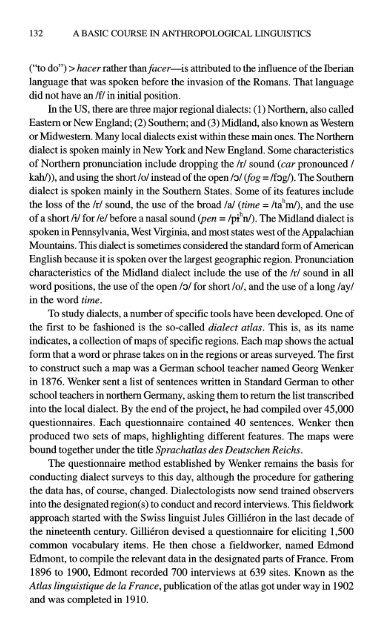A Basic Course in Anthropological Linguistics (Studies in Linguistic ...
A Basic Course in Anthropological Linguistics (Studies in Linguistic ...
A Basic Course in Anthropological Linguistics (Studies in Linguistic ...
Create successful ePaper yourself
Turn your PDF publications into a flip-book with our unique Google optimized e-Paper software.
132 A BASIC COURSE IN ANTHROPOLOGICAL LINGUISTICS<br />
(“to do”) > hacer rather thanfacer-is attributed to the <strong>in</strong>fluence of the Iberian<br />
language that was spoken before the <strong>in</strong>vasion of the Romans. That language<br />
did not have an /f/ <strong>in</strong> <strong>in</strong>itial position.<br />
In the US, there are three major regional dialects: (1) Northern, also called<br />
Eastern or New England; (2) Southern; and (3) Midland, also known as Western<br />
or Midwestern. Many local dialects exist with<strong>in</strong> these ma<strong>in</strong> ones. The Northern<br />
dialect is spoken ma<strong>in</strong>ly <strong>in</strong> New York and New England. Some characteristics<br />
of Northern pronunciation <strong>in</strong>clude dropp<strong>in</strong>g the /r/ sound (car pronounced /<br />
kah/)), and us<strong>in</strong>g the short /o/ <strong>in</strong>stead of the open /a/ vog = /fag/). The Southern<br />
dialect is spoken ma<strong>in</strong>ly <strong>in</strong> the Southern States. Some of its features <strong>in</strong>clude<br />
the loss of the /r/ sound, the use of the broad /a/ (time = /ta”m/), and the use<br />
of a short /i/ for /e/ before a nasal sound (pen = /pihn/). The Midland dialect is<br />
spoken <strong>in</strong> Pennsylvania, West Virg<strong>in</strong>ia, and most states west of the Appalachian<br />
Mounta<strong>in</strong>s. This dialect is sometimes considered the standard form of American<br />
English because it is spoken over the largest geographic region. Pronunciation<br />
characteristics of the Midland dialect <strong>in</strong>clude the use of the /r/ sound <strong>in</strong> all<br />
word positions, the use of the open /a/ for short /o/, and the use of a long /ay/<br />
<strong>in</strong> the word time.<br />
To study dialects, a number of specific tools have been developed. One of<br />
the first to be fashioned is the so-called dialect atlas. This is, as its name<br />
<strong>in</strong>dicates, a collection of maps of specific regions. Each map shows the actual<br />
form that a word or phrase takes on <strong>in</strong> the regions or areas surveyed. The first<br />
to construct such a map was a German school teacher named Georg Wenker<br />
<strong>in</strong> 1876. Wenker sent a list of sentences written <strong>in</strong> Standard German to other<br />
school teachers <strong>in</strong> northern Germany, ask<strong>in</strong>g them to return the list transcribed<br />
<strong>in</strong>to the local dialect. By the end of the project, he had compiled over 45,000<br />
questionnaires. Each questionnaire conta<strong>in</strong>ed 40 sentences. Wenker then<br />
produced two sets of maps, highlight<strong>in</strong>g different features. The maps were<br />
bound together under the title Sprachatlas des Deutschen Reichs.<br />
The questionnaire method established by Wenker rema<strong>in</strong>s the basis for<br />
conduct<strong>in</strong>g dialect surveys to this day, although the procedure for gather<strong>in</strong>g<br />
the data has, of course, changed. Dialectologists now send tra<strong>in</strong>ed observers<br />
<strong>in</strong>to the designated region(s) to conduct and record <strong>in</strong>terviews. This fieldwork<br />
approach started with the Swiss l<strong>in</strong>guist Jules Gillikron <strong>in</strong> the last decade of<br />
the n<strong>in</strong>eteenth century. Gillikron devised a questionnaire for elicit<strong>in</strong>g 1,500<br />
common vocabulary items. He then chose a fieldworker, named Edmond<br />
Edmont, to compile the relevant data <strong>in</strong> the designated parts of France. From<br />
1896 to 1900, Edmont recorded 700 <strong>in</strong>terviews at 639 sites. Known as the<br />
Atlas l<strong>in</strong>guistique de la France, publication of the atlas got under way <strong>in</strong> 1902<br />
and was completed <strong>in</strong> 1910.






